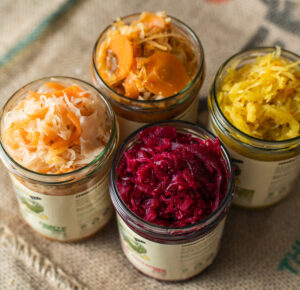Fermented foods have been a part of human diets for centuries, and for good reason. Fermentation is a natural process in which microorganisms like bacteria, yeasts, and fungi convert carbohydrates into alcohol or acids, resulting in the preservation and transformation of food. Fermented foods offer a host of benefits, including improved gut health, increased nutrient absorption, and enhanced flavor. In this article, we will discuss the benefits of fermented foods, how to make them, and some recipes for incorporating them into your diet.
Benefits of Fermented Foods
One of the main benefits of fermented foods is their impact on gut health. Fermentation produces probiotics, which are beneficial bacteria that live in our gut and aid in digestion and nutrient absorption. Probiotics also help maintain a healthy balance of gut bacteria, which is crucial for overall health. Fermented foods can also boost the immune system, improve mood, and even aid in weight loss.
Fermentation can also increase the bioavailability of nutrients in food. For example, the fermentation of soybeans in the production of tempeh increases the availability of protein, iron, and calcium. Fermented vegetables like sauerkraut and kimchi also contain higher levels of vitamins and minerals than their non-fermented counterparts.

Fermented foods
Finally, fermentation can enhance the flavor of food. Fermented foods have a tangy, sour, or even slightly alcoholic taste that can add depth and complexity to dishes.
How to Make Fermented Foods
While the thought of fermenting food may seem intimidating, it’s actually a simple and straightforward process. Here are the basic steps for fermenting vegetables:
- Choose your vegetables: Almost any vegetable can be fermented, but some popular choices include cabbage, carrots, and cucumbers.
- Prepare your vegetables: Wash and chop your vegetables into small pieces.
- Add salt: Salt is necessary for the fermentation process, as it inhibits the growth of harmful bacteria. Add 1-2 tablespoons of salt per quart of vegetables and mix well.
- Pack the vegetables into a jar: Use a glass jar with a tight-fitting lid. Pack the vegetables tightly into the jar, leaving about an inch of space at the top.
- Add water: Add enough water to cover the vegetables completely, leaving about an inch of space at the top.
- Weigh down the vegetables: Use a weight to keep the vegetables submerged in the brine. You can use a small glass jar filled with water or a specialized fermentation weight.
- Cover the jar: Cover the jar with a clean cloth or a specialized fermentation lid that allows gases to escape.
- Ferment the vegetables: Store the jar in a cool, dark place and allow the vegetables to ferment for 1-4 weeks, depending on your preference.
Recipes for Incorporating Fermented Foods into Your Diet
Fermented foods can be eaten on their own or used as a condiment in a variety of dishes. Here are some recipes for incorporating fermented foods into your diet:
- Kimchi Fried Rice: Heat some oil in a skillet and sauté chopped onions, garlic, and diced vegetables like carrots and bell peppers. Add cooked rice and a spoonful of kimchi, and stir well until heated through. Top with a fried egg and chopped scallions.
- Beet Kvass: Peel and chop 2-3 beets and place them in a glass jar. Add 1-2 tablespoons of salt and enough water to cover the beets. Cover the jar and let it ferment for 3-5 days, then strain out the beets and drink the liquid as a refreshing and detoxifying beverage.
- Fermented Salsa: Combine chopped tomatoes, onions, garlic, and jalapeños in a glass jar. Add salt

